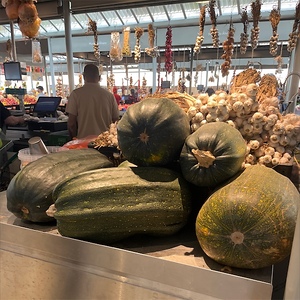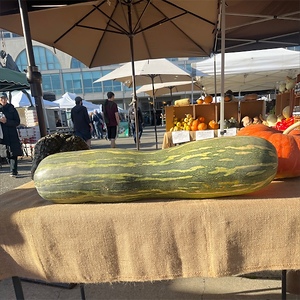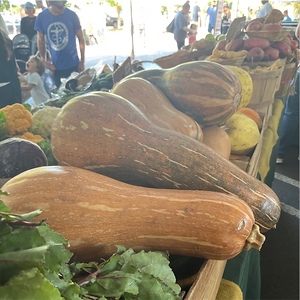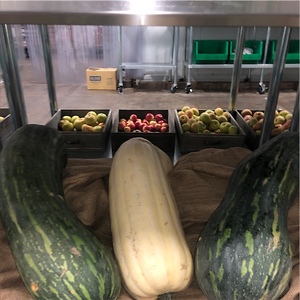


Lunga Di Napoli Squash
Estimated Inventory, lb : 0
Description/Taste
Lunga di Napoli squash is large to extremely large in size, averaging 60-120 centimeters in length and 20-70 pounds in weight, and has an oblong, cylindrical shape with a slightly bulbous end. The smooth skin ripens from yellow to a dark green-grey, and when mature, it also bears orange to light green striations. The thick flesh is dense, firm, a deep, vibrant orange, and the bulbous end encases a small cavity filled with stringy pulp and many flat, cream-colored seeds. When cooked, Lunga di Napoli is smooth and dry with a mild, slightly sweet flavor, similar to butternut squash.
Seasons/Availability
Lunga di Napoli squash is available in the fall through winter.
Current Facts
Lunga di Napoli squash, botanically classified as Cucurbita moschata, is an Italian heirloom variety that grows on a long vining plant and is a member of the Cucurbitaceae family along with pumpkins and gourds. Also known as Piena di Napoli, Courge Pleine d’Alger, Long of Naples, and Courge Pleine di Naples, Lunga di Napoli is a large winter squash that is a part of what has come to be known as the neck group of squashes which contains squash with elongated necks such as butternut, crookneck, and Tahitian. Lunga di Napoli translated means "Long of Naples," and the squash is known for its enormous size, tender texture, and dense flesh.
Nutritional Value
Lunga de Napoli is rich in beta-carotene, which is a nutrient that is also responsible for the color of its flesh, and vitamin C.
Applications
Lunga di Napoli squash is best suited for cooked applications such as baking, braising, boiling, sautéing, steaming, and roasting, and the skin can be removed either before or after cooking, depending on preference. The cooked squash can be pureed and added to soups, curry, pies, preserves such as zucca da marmaletta or pumpkin jam, quick bread, gnocchi, ravioli, and sauces. It can also be cubed, cooked, and added to risottos, pasta, pizza, casseroles, and empanadas or made into squash fritters. Lunga di Napoli squash pairs well with white beans, sage, mint, parsley, chard, kale, eggplant, pear, plum, tomato, celery, shallot, garlic, cinnamon, nutmeg, vinegar, chili pepper, and olive oil. It will keep up to a month when stored in a cool, dry, dark place.
Ethnic/Cultural Info
Lunga di Napoli squash has been a popular variety in Italy for centuries, specifically in the southern regions. In Campania, Sicily, and Puglia, it is used in the regional soup known as cianfotta or giambotta and is made with chili pepper, eggplant, tomato, pears, and plums. Lunga di Napoli squash is also popularly served fried, chilled, and scapece style dressed in vinegar, oil, garlic, mint, and sugar in Sicily or chili in Campania. The squash is commonly sold in packaged slices in Europe due to its large size, and the seeds are also used as a snack food throughout Italy, served simply toasted and salted.
Geography/History
Lunga di Napoli squash is a common variety in Italy and the Mediterranean region, and mention of it can be found dating back to 1856 in Vilmorin’s classic illustrated album of French garden vegetables, The Vegetable Garden. Lunga di Napoli squash is then believed to have first appeared in an American seed catalog in 1863 listed by Fearing Burr. Though it has never caught on as a commercially viable squash variety in the United States, it has found popularity among home growers and competitive growers as a result of its ability to grow to massive sizes. Today Lunga di Napoli squash can be found at farmers markets, specialty grocers, and online seed catalogs in Europe, Asia, Australia, and the United States.











